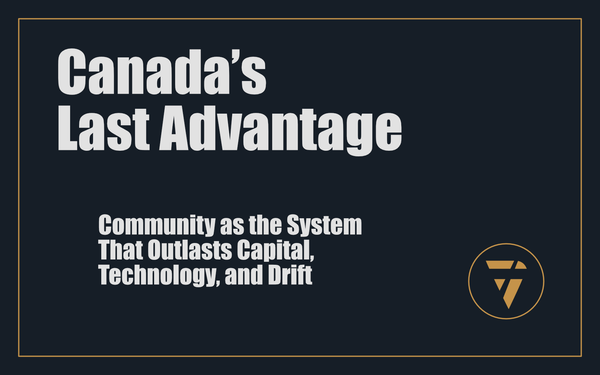The Space Between Leaving and Beginning

A Bakery That Bought Itself
It started with a quiet woman in a small town bakery.
The kind of place where the floor creaks, the regulars linger, and the back door never locks. She didn’t talk much about how hard it had been, but you could see it in her hands. Years of early mornings. Staff no-shows. Rent increases. Christmas rushes. A hundred quiet battles fought in silence.
She didn’t inherit the place. She earned it.
A Bakery Becomes a Bridge
In a rural town marked more by memory than momentum, a bakery sits on the corner of Main Street and Railway. It’s the kind of place that still knows the names of its customers. Flour under the fingernails. Coffee before the sun comes up. The heartbeat of a town that’s long since outgrown its reasons to stay, but hasn’t yet found its reasons to leave.
The owner? A woman in her fifties. Far from home. Tired but proud. She didn’t inherit the bakery, she endured it. Built it up, held it steady, carried it through sickness, staff changes, and the slow erosion of small-town foot traffic. Her family, aging and distant, calls to her more loudly each year. But the bakery — her daily rhythm, her social world, her sense of purpose — holds her like a gravity she can’t quite escape.
She doesn’t want to sell to strangers.
She doesn’t want to abandon what she built.
She doesn’t want to discount the business just to be done.
And yet, she’s done. Quietly. She just can’t say it out loud.
Enter the buyer: a small family, mid-30s, with a toddler and a dream. No MBA. No capital reserves. Just a baker’s hands, a builder’s heart, and a sense that they could make something beautiful in this place, if given the chance.
But banks don’t fund dreams.
Lawyers don’t write trust.
And neither party knows how to cross the chasm.
They sit at the table, two people trying to do the right thing, without the tools, the language, or the framework to get there.
And then something rare happens:
They stop thinking like buyers and sellers.
And start thinking like stewards.
Not “How do we protect ourselves?”
But “How do we protect this?”
Not “How do I extract value?”
But “How do I preserve meaning?”
They build a structure, not a sale.
They write a transition, not a transaction.
The buyer gets to run the bakery from day one, but doesn’t own it.
The seller keeps title, but hands over the keys.
Every dollar above salary flows to the seller until the full price is paid.
Every upgrade is logged, approved, and protected.
Every month, they share statements, not surprises.
No banks.
No interest.
No inflated promises.
Just a deal built on mutual clarity and mutual consequence.
And when the seller is ready — when she’s trained the new owner, passed on the recipes, said goodbye to her customers — she leaves. With dignity. With trust. With full value.
No fights.
No lawyers.
No broken hearts.
Just a quiet, clean handoff, the kind that never makes headlines, but should.
Because in a world full of exits that burn bridges...
This one built a new road.
The Space Between Leaving and Beginning
She didn’t inherit the place. She earned it.
And now she needed to leave. Not because the business was failing. But because her life — the one with aging parents and children in another province — was waiting. She needed to go home.
But there was no buyer.
Not one who could pay.
Not one who would honour the work.
Then came the young woman.
No suit. No pitch deck. No cheque.
Just a baker’s instinct and a toddler on her hip.
She didn’t have the money. But she had something else:
She wanted to belong. To carry something forward. To build on what was already rooted.
And for a moment, they sat across from each other, unsure how to move.
No bank would touch the deal.
No broker could justify the value.
No lawyer had a contract template for this kind of transfer.
But they didn’t need any of that.
They just needed to ask a different question:
What if we trusted the business to fund its own future?
So they built something new. Not a transaction. A transition.
The young baker would take over operations. Run the shop. Pay herself a living wage. And every dollar above that — every bit of real profit — would flow to the owner. Until the full value was paid.
Not a discount.
Not an earnout.
Not a gamble.
Just time. Trust. And structure.
Ownership stayed with the seller until the final dollar was transferred. Every improvement logged. Every expense approved. Monthly statements. Shared clarity. No smoke. No secrets.
The older woman trained the younger.
Passed on her recipes. Her routines. Her quiet wisdom.
And when she saw it was working — when she saw it was hers — she let go.
She left.
Not compromised.
But complete.
And the bakery?
It never closed. Not for a day.
Same smell. Same counter.
New hands.
Same heart.
This isn’t a case study.
It’s a reminder.
That value doesn’t live in documents.
It lives in motion.
In mutual belief.
In the courage to design something honest when the old tools don’t fit.
There are a thousand businesses right now, caught in the space between leaving and beginning. And they don’t need better lawyers.
They need better questions.
Better bridges.
Better ways to walk each other home.
This is what I’m working on. Tell me what you think, I enjoy the conversation! Subscribe and follow the work in real time.
Thanks!
B

She didn’t need a loan. She needed a ladder.
The seller held title. The buyer ran the shop.
Every dollar of profit paid the price.
No debt. No fight. Just a clean handoff.
That’s what happens when structure replaces struggle.
PS -






